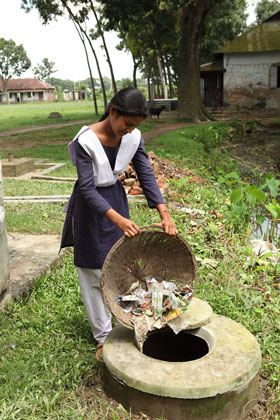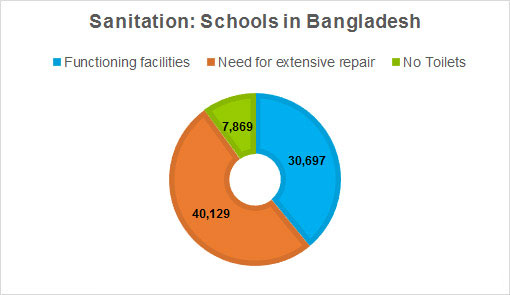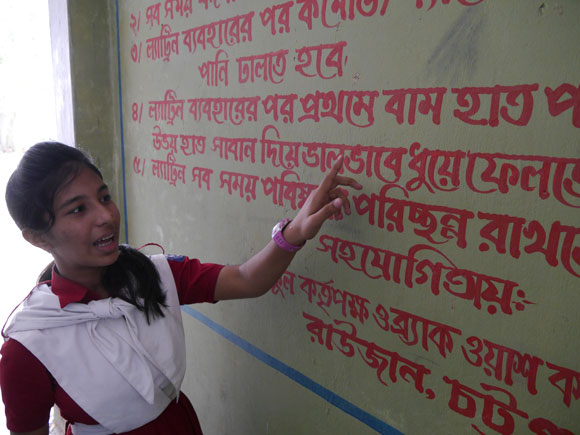Reading Time: 2 minutes
“A study undertaken in Bangladesh revealed an 11 per cent increase in girls’ enrolment mainly due to the provision of sanitary toilets.” -Technical paper series/IRC, In Bangladesh the standard number of toilets in schools has been set as a minimum of one toilet for every 60 students. However, this is far from being achieved. The infographic below shows that on average, schools in Bangladesh have half the number of toilets required. However, although 94 per cent of schools have latrines within the compound, a large number remain unusable because they are dirty or broken.
“A study undertaken in Bangladesh revealed an 11 per cent increase in girls’ enrolment mainly due to the provision of sanitary toilets.” –Technical paper series/IRC
In Bangladesh the standard number of toilets in schools has been set as a minimum of one toilet for every 60 students. However, this is far from being achieved. The infographic below shows that on average, schools in Bangladesh have half the number of toilets required. However, although 94 per cent of schools have latrines within the compound, a large number remain unusable because they are dirty or broken.
Recently, the Bangladesh government has begun addressing the issues of water and sanitation more actively. A recent round table discussion on School sanitation: reality and required action focused on a range of issues, from the number of functional toilets in schools to the lack of menstrual hygiene facilities.
BRAC has been running its water, sanitation and hygiene (WASH) programme in schools in rural settings since 2007. The programme has supported over 5,000 schools since, installing separate latrines for girls, including facilities for menstrual hygiene management and hygiene training.
Boali High School in Kaliganj sub-district is one of the schools where the programme is operating. Mahbuba Begum, head teacher of the school, said she was concerned with the unhygienic latrines. All students and teachers had to use the same toilets. The school also grappled with low student enrolment and high dropout rates.
In 2010, when BRAC WASH approached the school, Mahbuba convinced school authorities to build more toilets for girls. The deal was to include menstrual hygiene facilities like sanitary napkin supplies, napkin disposal bins and a pit for disposal of bin contents.
The lack of separate latrines for girls and menstrual hygiene facilities in secondary schools are major factors in disproportionate rate of absence and dropout of adolescent girls.
 Today the school has a student brigade maintaining WASH services. Hygiene lessons are integrated into the class routine. Most importantly, BRAC has found that many girls are more comfortable with buying napkins from the school rather than at the market. Supplied by the health workers at a lower price, girls are now more likely to buy sanitary napkins from the school. As a result, girls’ attendance has seen significant improvement. Improvements are also apparent in many other schools where WASH services have been made available.
Today the school has a student brigade maintaining WASH services. Hygiene lessons are integrated into the class routine. Most importantly, BRAC has found that many girls are more comfortable with buying napkins from the school rather than at the market. Supplied by the health workers at a lower price, girls are now more likely to buy sanitary napkins from the school. As a result, girls’ attendance has seen significant improvement. Improvements are also apparent in many other schools where WASH services have been made available.
The qualitative information system monitoring implemented by BRAC’s WASH programme shows that the use and cleanliness of facilities provided in secondary schools remain high.
Having started off as a means to address low attendance and high dropout rates for girls at schools, the programme has evolved to address the next series of threats towards improving education in Bangladesh. Careful assessment revealed that a safe water supply and sanitation facilities for boys is also essential to attain best results.
To address these needs, BRAC has recently started collaborating with Charity:Water. Water collection points, handwashing stations and separate toilets for boys are being installed in schools to meet the national standards.
For sustainable health impact, access to proper facilities and hygiene knowledge are essential. BRAC believes targeting school-going children is an effective way to spark change within communities.
Sabrina Shahidullah is a senior communications specialist for BRAC’s water, sanitation and hygiene programme.







